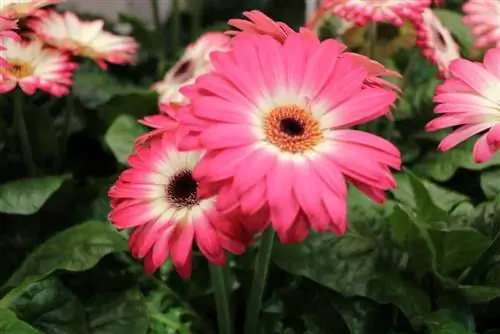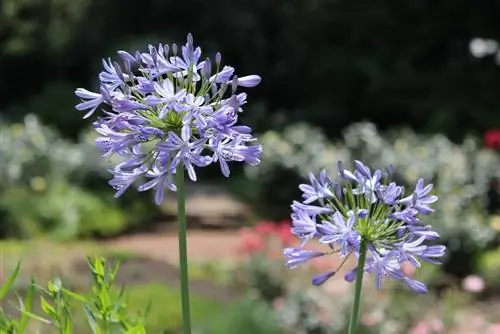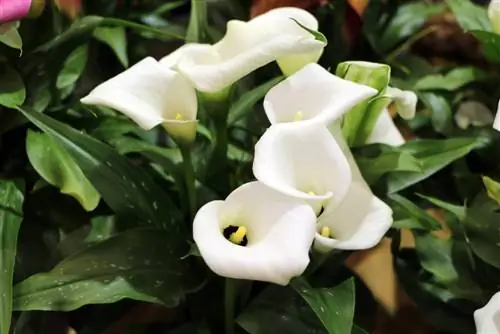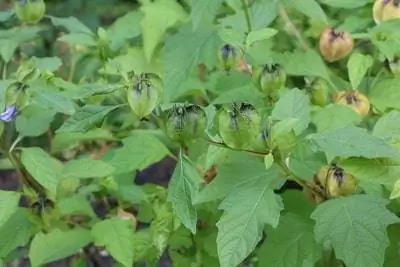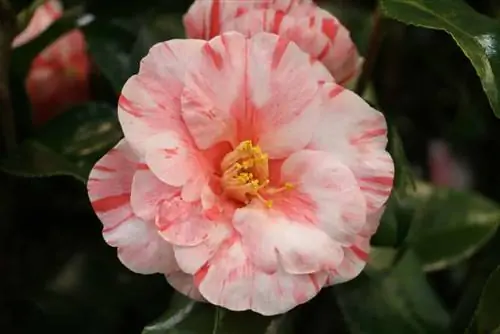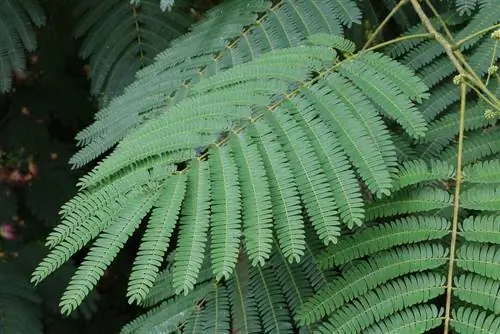- Author admin [email protected].
- Public 2023-12-17 03:39.
- Last modified 2025-01-24 12:45.
The Gerbera is a composite plant that is particularly valued for its beautiful, intensely colored and relatively large flowers. The gerbera is very well known and popular as a cut flower, but the plant can also be planted as a garden plant or on the terrace or balcony - ideally in a box or in a pot.
External features
The flowers of the cut flower gerbera look significantly different than the plant as a whole. Hairiness is also possible on the leaf surface. Leafless stems form from the rosette of leaves, at the top of which the flowers are cup-shaped. These flowers can be up to 10 cm in diameter.
Care
Due to its origin, the gerbera generally loves warmth. That's why the plant appreciates a sunny location, especially in our regions, which are relatively mild for this plant. What is very interesting about the gerbera is that the older plants can be propagated and rejuvenated by root division. The plant is generally propagated via seeds. It is important for the he alth of the plant that it receives regular watering with lime-free water in summer. By the way, the gerbera tolerates rainwater best when watering. It should be noted that the plant always needs slightly moist soil. However, it is absolutely important to avoid waterlogging, as the plant reacts very sensitively to it. The gerbera forms so-called rhizomes as survival organs.
The roots of the plant are therefore very sensitive to waterlogging and also have a strong tendency to brown. Due to its origin, the beautiful plant prefers it to be very warm. The plant thrives best at temperatures between 16 °C and 20 °C. In addition to regular watering, the plant needs fertilization with liquid fertilizer once a month. Fertilization should be carried out regularly between April and September. Fertilization is required at least once a year. A practical alternative for optimal nutrient supply to the plant is to supply long-term fertilizer.
Very beautiful and durable cut flowers for indoor use can also be produced from garden plants. While the plant likes temperatures between 16 °C and 20 °C in the warm season, it appreciates a slightly cooler location in winter. During the cool season, the plant is content with an ambient temperature of 12 °C to 15 °C. This should also be taken into account when overwintering the plant.
Needs
- a sunny location
- regular watering, preferably lime-free (preferably rainwater)
- no waterlogging
- a monthly fertilization
Planting

The gerbera should be planted as a pot plant in fresh and rather sandy potting soil. It should be taken into account that the substrate of the potted plant should never dry out in summer, but should also never be watered too heavily and that waterlogging should be avoided. It can be very useful to water the potted plant from below into the planter. Then wait a few minutes and pour off the excess water that the plant has not absorbed. This is the best way to avoid waterlogging, especially for potted plants.
Wintering
If the gerbera is to be overwintered, this should be done in a room with a room temperature of 12 °C to 15 °C. If the temperatures are below this, it is possible that the plant will begin to rot during winter dormancy. The early stages of the rotting process can be recognized by the slight gray coloring of the leaves. During winter dormancy, the gerbera needs less water than in summer, so it should only be watered sparingly. No fertilization is required during winter rest. However, even during winter rest, you should make sure that the plant gets enough fluid despite sparse watering, because the root ball must not dry out under any circumstances.
This is the best way toOverwintering:
- at a room temperature of 12 °C to 15 °C
- with sparing watering, but without drying out the root ball
- without fertilization
Propagate Gerbera Plants
The plant can be grown from seeds either in February or in mid-September. However, the seed must be very fresh because gerbera seeds lose their ability to germinate very quickly. The most favorable temperature for seed germination is 22°C to 24°C. In addition to growing from seeds, propagation can also be achieved by dividing older plants. If you have a green thumb, you can propagate plants, especially with very unusual varieties, using cuttings.
Pests and diseases
Gerbera blight is the worst disease that can affect the plant. When infected, the leaves of the plant turn from pale green to gray-brown and ultimately the gerbera rots both at the base of the trunk and at the roots. The triggers for the disease are excessive soil moisture and temperatures that are too low, possibly too acidic soil or too intensive fertilization. If the plant is affected by this disease, it can no longer be saved and should be thrown away immediately.
Gray mold appears on the plant when it doesn't get enough fresh air, when the plants are too close together or when the soil is too wet or the temperatures fluctuate significantly. If the disease is caused by gray mold, the diseased leaves can be plucked off and the rest of the plant can then be protected from further infection by spraying with a fungicide. It is then also important to change the unfavorable environmental conditions. Whiteflies and aphids can be rinsed off in the early stages of infestation, otherwise they can be treated with yellow tablets inserted into the pot.
Damage to the plant occurs particularly with:
- too much soil moisture and too low temperatures (gerbera rot)
- too little fresh air (gray mold)
- Aphids and whiteflies
What you should know in brief
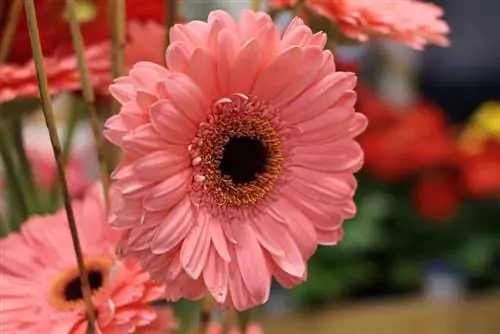
The Gerbera belongs to the Asteraceae family. It is often used as a cut flower because of its beautiful, intensely colored and relatively large flowers, but can also be best planted in a box or pot in your own garden or on the terrace or balcony. Because you have to keep in mind that the gerbera is not originally native to this country.
- Gerberas occur naturally in Asia and South Africa.
- It is a perennial herbaceous plant, but is not hardy.
- Therefore, cultivation in this country is possible as a container, box or potted plant.
- The gerbera forms rhizomes as survival organs.
- Their roots are sensitive to waterlogging and tend to brown.
- Their simple or pinnate leaves are arranged together in basal rosettes.
- The leaf surface can be both hairy and hairless.
- Long leafless stems form from the rosette of leaves, at the top of which are the cup-shaped flowers.
- Gerbera flowers can reach a diameter of up to 10 cm.
- Gerberas thrive best at temperatures around 16 to 20 degrees Celsius.
- They want to be supplied with liquid fertilizer at least once a month - between April and September.
- The plants can be used both as cut flowers and as potted plants.
Varieties
Gerberas are available in a wide variety of colors - from pure white to yellow, pink and strong dark red flowers. Two-tone flowers are also possible. There are around 70 different types of gerberas alone, including potted gerberas. There is therefore an extensive variety of this ornamental plant. New varieties are constantly coming from large nurseries. Every year, around 80 new varieties are brought onto the market by Dutch gerbera breeders. The most promising variety is then chosen every year. For example, as part of the 2011 review of new bedding and balcony plants, the Bavarian State Institute for Viticulture and Horticulture Veitshöchheim has put together some Gerbera varieties:
- Gerbera 'Everlast Carmine', 'Everlast Orange', 'Everlast White', 'Garvinea Cindy', 'Garvinea Fleurie', 'Garvinea Lindsey' in strong pink with a dark center
- ‘Garvinea Romy’ in red with a light center
- 'Garvinea Sunny', 'Garvinea Valerie' soft pink with light center
- 'Garvinea Vivian' in yellow and light in the middle,
- 'Grandera Orange', 'Grandera Red', 'Grandera Salmon Spider' and 'Grandera White'

